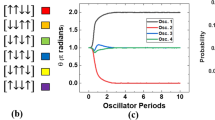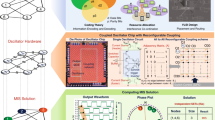Abstract
Computational architectures that are optimized to solve non-deterministic polynomial-time hard or complete problems are of use in the development of machine learning, logistical planning and pathfinding. A range of quantum-, optical- and spintronic-based approaches have been explored for solving such combinatorial optimization problems, but they remain complicated to build and to scale. Here we report a scalable ring-oscillator-based integrated circuit for optimization problem solving. Our 1,968-node King’s graph ring oscillator array has five levels of coupling strengths and can achieve up to 95% accuracy for randomly generated combinatorial optimization problems. The measured average power consumption of the Ising chip is 0.042 W and it takes less than 50 oscillation cycles to resolve to the ground state. Our device is resilient to environmental and variation effects. By using a multi-phase phase measurement circuit, we also capture the true phase behaviour within a coupled-oscillator integrated circuit.
This is a preview of subscription content, access via your institution
Access options
Access Nature and 54 other Nature Portfolio journals
Get Nature+, our best-value online-access subscription
$29.99 / 30 days
cancel any time
Subscribe to this journal
Receive 12 digital issues and online access to articles
$119.00 per year
only $9.92 per issue
Buy this article
- Purchase on Springer Link
- Instant access to full article PDF
Prices may be subject to local taxes which are calculated during checkout





Similar content being viewed by others
Data availability
The problem set and test data presented in this paper are available at https://figshare.com/projects/A_1_968_node_coupled_ring_oscillator_circuit_for_combinatorial_optimization_problem_solving/134594.
Code availability
The code used to generate the optimal Hamiltonians is available at https://figshare.com/projects/A_1_968_node_coupled_ring_oscillator_circuit_for_combinatorial_optimization_problem_solving/134594.
References
Yang, G. Industrial Applications of Combinatorial Optimization (Springer, 1998).
Vangelis, T. P. Applications of Combinatorial Optimization 2nd edn (Wiley, 2014).
Markov, I. L. Limits on fundamental limits to computation. Nature 512, 147–154 (2014).
Markov, I. L. Know your limits. IEEE Des. Test 30, 78–83 (2013).
Hoover, H. J. Greenlaw, R. & Ruzzo, W. L. Limits to Parallel Computation: P-Completeness Theory (Oxford Univ. Press, 1995).
Date, P., Arthur, D. & Pusey-Nazzaro, L. QUBO formulations for training machine learning models. Sci. Rep. 11, 10029 (2021).
Glover, F. Kochenberger, G. & Du, Y. A tutorial on formulating and using QUBO models. Preprint at https://arxiv.org/abs/1811.11538 (2019).
Lucas, A. Ising formulations of many NP problems. Front. Phys. 2, 5 (2014).
Ising, E. Beitrag zur theories des ferromagnetismus. Z. Phys. 31, 253–258 (1925).
Neogy, T. & Roychowdhury, J. Analysis and design of sub-harmonically injection locked oscillators. In 2012 Design, Automation & Test in Europe Conference & Exhibition (DATE) 1209–1214 (IEEE, 2012).
Böhm, F., Verschaffelt, G. & Van der Sande, G. A poor man’s coherent Ising machine based on opto-electronic feedback systems for solving optimization problems. Nat. Commun. 10, 3538 (2019).
Vadlamani, S. K., Xiao, T. P. & Yablonovitch, E. Physics successfully implements Lagrange multiplier optimization. Proc. Natl Acad. Sci. USA 117, 26639–26650 (2020).
Mallick, A. et al. Using synchronized oscillators to compute the maximum independent set. Nat. Commun. 11, 4689 (2020).
Yamaoka, M. et al. A 20k-spin Ising chip to solve combinatorial optimization problems with CMOS annealing. IEEE J. Solid-State Circuits 51, 303–309 (2016).
Hsu, J. How much power will quantum computing need? IEEE Spectrum 5 (2015).
Yamamoto, Y. et al. Coherent Ising machines—optical neural networks operating at the quantum limit. npj Quantum Inf. 3, 49 (2017).
Borders, W. et al. Integer factorization using stochastic magnetic tunnel junctions. Nature 573, 390–393 (2019).
Honjo, T. et al. 100,000-spin coherent Ising machine. Sci. Adv. 7, eabh0952 (2021).
Wang, T. & Roychowdhury, J. Oscillator-based Ising machine. Preprint at https://arxiv.org/abs/1709.08102 (2017).
Glover, F. Tabu search—part I. ORSA J. Comput. 1, 190–206 (1989).
Glover, F. Tabu search—part II. ORSA J. Comput. 2, 4–32 (1990).
Ahmed, I. Chiu, P.-W., Moy, W. & Kim, C. H. A probabilistic compute fabric based on coupled ring oscillators for solving combinatorial optimization problems. IEEE J. Solid-State Circuits 56, 2870–2880 (2021).
Takemoto, T. et al. A 2 × 30k-spin multi-chip scalable CMOS annealing processor based on a processing in-memory approach for solving large-scale combinatorial optimization problems. IEEE J. Solid-State Circuits 55, 145–156 (2020).
Takemoto, T. et al. 4.6 A 144Kb annealing system composed of 9×16Kb annealing processor chips with scalable chip-to-chip connections for large-scale combinatorial optimization problems. In 2021 IEEE International Solid-State Circuits Conference (ISSCC) 64–66 (IEEE, 2021).
Bian, Z. et al. The Ising model: teaching an old problem new tricks. D-Wave Systems 2, 1–32 (2010)
Dutta, S. et al. Experimental demonstration of phase transition nano-oscillator based Ising machine. In 2019 IEEE International Electron Devices Meeting (IEDM) 37.8.1–37.8.4 (IEEE, 2019).
Wang, T., Wu, L. & Roychowdhury, J. New computational results and hardware prototypes for oscillator-based Ising machines. In Proc. 56th Annual Design Automation Conference 2019 56, 1–2 (IEEE, 2019).
Acknowledgements
I.A. and C.H.K. acknowledges the initial support of the project from the National Science Foundation under ECCS 1739635 and the Semiconductor Research Corporation (SRC) under 2759.007. For the chip testing and data analysis works, W.M. and C.H.K. have been supported in part by the SRC under 3024.001. We would like to thank SRC’s industry liaisons for their technical feedback.
Author information
Authors and Affiliations
Contributions
W.M., I.A., P.-W.C., S.S.S. and C.H.K. participated in the circuit and architecture design of the integrated circuit. W.M., I.A. and P.-W.C. created the layout for the fabrication of the integrated circuit. W.M. and C.H.K. performed the testing and measurement of the chip. J.M. created the cloud-testing interface and testing automation setup for the chip.
Corresponding author
Ethics declarations
Competing interests
The authors declare the following competing interest: US patent application 17/213,396 (Probabilistic compute engine using coupled ROSCs).
Peer review
Peer review information
Nature Electronics thanks Michael Huang and the other, anonymous, reviewer(s) for their contribution to the peer review of this work.
Additional information
Publisher’s note Springer Nature remains neutral with regard to jurisdictional claims in published maps and institutional affiliations.
Extended data
Extended Data Fig. 1 Raw phase map data with post-processed results.
Raw phase maps are shown for uniform, chequerboard, and random pattern graphs. A lightweight post-processing method that emphasizes the relative phase difference between adjacent nodes can eliminate non-ideal effects and produce the expected spin value maps on the right. The weights and spin values are colour coded and overlaid for better visualization. ROSCs are indexed from 1 (upper left corner) to 1,968 (lower right corner), with ROSC 1 being directly above ROSC 42.
Rights and permissions
About this article
Cite this article
Moy, W., Ahmed, I., Chiu, Pw. et al. A 1,968-node coupled ring oscillator circuit for combinatorial optimization problem solving. Nat Electron 5, 310–317 (2022). https://doi.org/10.1038/s41928-022-00749-3
Received:
Accepted:
Published:
Issue Date:
DOI: https://doi.org/10.1038/s41928-022-00749-3
This article is cited by
-
Point convolutional neural network algorithm for Ising model ground state research based on spring vibration
Scientific Reports (2024)
-
Ferroelectric compute-in-memory annealer for combinatorial optimization problems
Nature Communications (2024)
-
Efficient optimization with higher-order Ising machines
Nature Communications (2023)
-
Efficient combinatorial optimization by quantum-inspired parallel annealing in analogue memristor crossbar
Nature Communications (2023)
-
Oscillators do the hard bits
Nature Electronics (2023)



